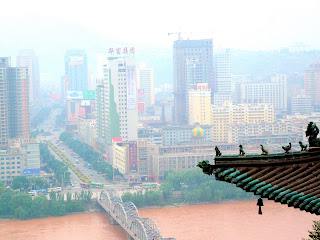Xian to Beijing - Part 2 Dunhuang to Xining
Dunhuang is in the middle of the Gobi desert. I travelled there by sleeper train again - this time about 22 hours. The train was almost empty. Very quiet and comfortable. I woke up about 6:30am as usual and looked out the window to see the other-worldly landscape of the desert. Sand as far as you can see, but not flat and windblown like I expected, rather with craters and gulleys like dried rivers. There was a huge sand dune mountain running parallel to the railway line and snow capped mountains behind that.
The train line to Dunhuang is new. It's not on most maps. They haven't even finished the railway station yet. It's the first railway station I have seen in China that is not in the center of the city. It's about 10km outside of town and across the road from the small airport.

The two main reasons to come to Dunhuang are for the Mogao Caves and the giant sand dune which they call Mingsha Mountain .There wasn't a lot to do in Dunhuang unless you wanted to pay lots of money to go to the overly touristy Cresent Moon Lake and pay more money to do adventure sports like Jeep rides or quad bikes in the sand or camel rides or sand surfing, sledding, etc...
An eclectic crew of 4 foreigners (isreali, british, japanese & american) met on the streets of the sleepy desert town that day and decided to all go on a camel trek and camping in the desert.
I love the camel's feet. I thought they would be like a horse's hoof, but they aren't. They are soft and hairy.
Camping in the desert was really fun. We climbed to the top of the sand dune to watch the sunset, then slept under the stars (actually it was cloudy like usual in china) so we slept under the clouds which were under the stars. It was so silent and black in the desert. So peaceful. When you camp in the gobi desert, you would never know you are actually in the country with the world's largest population.
I visited Mogao Caves too which I think was way over priced. There are hundreds of caves carved into the side of the sand mountain. Traders and rich merchants travelling along the silk road would sponsor a cave to be built and decorated with buddhist art (paintings on the walls, sculptures, etc. ) The third largest buddha statue in the world is here. It is 34.5m tall.
If you're really into Buddhist art, then maybe it's worth it, but if I had known how expensive it has gotten (100RMB = $13), I probably wouldn't have made the trip at all. But then I wouldn't have seen the desert and taken the really fun camel trekking trip. So I don't regret it.
Lanzhou - Gansu Province
From Dunhuang, I took another sleeper train (16 hours) back to Lanzhou, the capital of Gansu province. I was getting good at buying train tickets by myself by this point. As soon as I got to Lanzhou, I bought a ticket to go to Xining, the capital of Qinghai Province which was about 3 hours away. I had about 4 hours to wait in Lanzhou, so I stored my luggage and set out to explore and find some lunch. Lanzhou is located on the Yellow River (Huang Jiang) which is really muddy.
I had a surprise when the pre-packaged Yak meat I bought in town ended up looking like a dog bone. It was a fun day.
It is now home to the controversial 15th Dalai Lama, a 7 year old boy. My tour guide knew some of the monks and was able to get me in to meet him. He is a very serious little boy. He now belongs to the tibetan people and is not allowed to see his family. It is his destiny to rule a country in turmoil.
I was impressed with one of his children's books which had pictures and the corresponding Tibetan, Chinese and English words.























0 Comments:
Post a Comment
<< Home